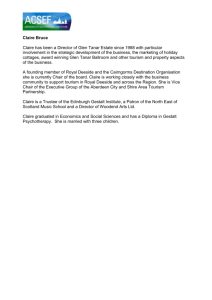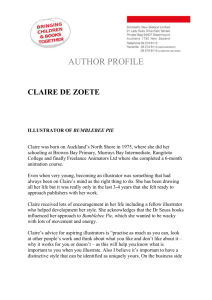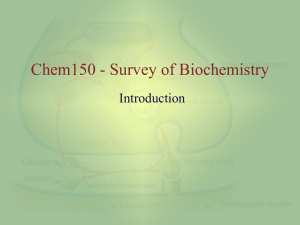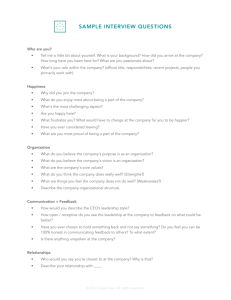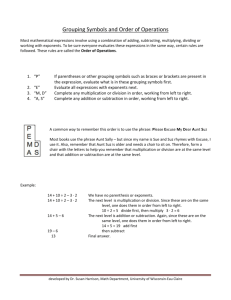Chem101 General Chemistry Organic Compounds Organic
advertisement
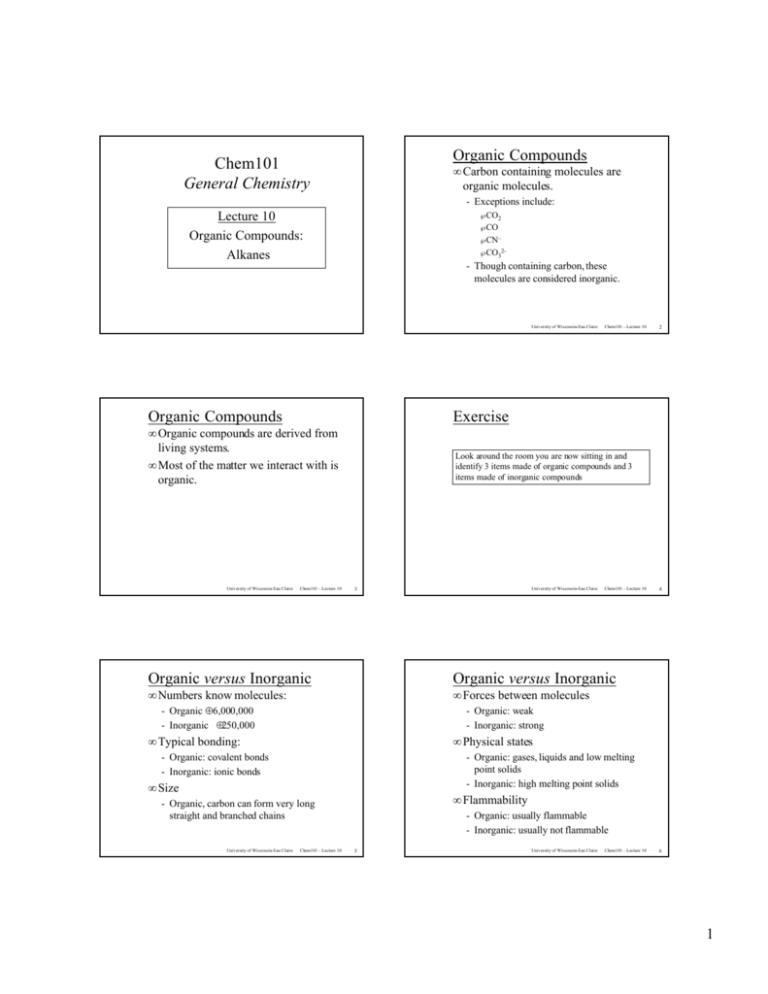
Organic Compounds Chem101 General Chemistry • Carbon containing molecules are organic molecules. - Exceptions include: √ Lecture 10 Organic Compounds: Alkanes √ √ √ CO2 CO CN– CO32- - Though containing carbon, these molecules are considered inorganic. University of Wisconsin-Eau Claire Chem101 - Lecture 10 Organic Compounds Exercise • Organic compounds are derived from living systems. • Most of the matter we interact with is organic. Look around the room you are now sitting in and identify 3 items made of organic compounds and 3 items made of inorganic compounds University of Wisconsin-Eau Claire Chem101 - Lecture 10 University of Wisconsin-Eau Claire 3 Chem101 - Lecture 10 Organic versus Inorganic Organic versus Inorganic • Numbers know molecules: • Forces between molecules - Organic ≈ 6,000,000 - Inorganic ≈250,000 4 - Organic: weak - Inorganic: strong • Typical bonding: • Physical states - Organic: covalent bonds - Inorganic: ionic bonds - Organic: gases, liquids and low melting point solids - Inorganic: high melting point solids • Size • Flammability - Organic, carbon can form very long straight and branched chains University of Wisconsin-Eau Claire 2 Chem101 - Lecture 10 - Organic: usually flammable - Inorganic: usually not flammable 5 University of Wisconsin-Eau Claire Chem101 - Lecture 10 6 1 Exercise 11.5 Exercise 11.9 Classify each of the following compounds as organic or inorganic: Devise a test, based on the general properties in Table 11.1, that you could use to quickly distinguish between the substances in each of the following pairs: a. KBr b. H2O a. Gasoline (liquid, organic) and water (liquid, inorganic) c. H-C≡C-H b. Naphthalene (solid, organic) and sodium chloride (solid, inorganic) Methane (gaseous, organic) and hydrogen chloride (gaseous, inorganic) d. Li c. e. CH 3-NH 3 University of Wisconsin-Eau Claire Chem101 - Lecture 10 7 University of Wisconsin-Eau Claire Chem101 - Lecture 10 Bonding Characteristics Bonding Characteristics • Carbon has 4 electrons in its valence shell • Carbon needs 4 electrons to fill its valence shell • The two electrons in the 2p orbitals are in half-filled orbitals and therefore available to form covalent bonds. - However, this only allows carbon to form two covalent bonds and carbon needs four to satisfy the octet rule - The “octet” rule • The electronic configuration for carbon is 1s2,2s2,2p2 University of Wisconsin-Eau Claire Chem101 - Lecture 10 9 University of Wisconsin-Eau Claire Chem101 - Lecture 10 Bonding Characteristics Bonding Characteristics • Linus Pauling proposed a solution to this problem: • The 2s orbital mixes with the three 2p orbitals to form four hybrid orbitals having equal energies. - The 2s orbital mixes with the three 2p orbitals to form four hybrid orbitals having equal energies. - The hybrid orbitals are called sp3 orbitals. - Each of the four sp3 orbitals one valence electron and each can form a covalent bond. University of Wisconsin-Eau Claire Chem101 - Lecture 10 8 11 University of Wisconsin-Eau Claire Chem101 - Lecture 10 10 12 2 Bonding Characteristics Bonding Characteristics • The 2s orbital mixes with the three 2p orbitals to form four hybrid orbitals having equal energies. • The four sp3 orbitals point away from each other to form a tetrahedral geometry University of Wisconsin-Eau Claire Chem101 - Lecture 10 13 University of Wisconsin-Eau Claire Chem101 - Lecture 10 Bonding Characteristics Bonding Characteristics • In methane (CH4), each of the four sp3 orbitals forms a single σ (sigma) bond with a hydrogen atom • Carbon can also form single bonds with itself. 14 - This allows it to form long straight and branched chains of carbon. • Carbon can also from double and triple bonds with itself - This will be discussed in Chapter 12. University of Wisconsin-Eau Claire Chem101 - Lecture 10 15 University of Wisconsin-Eau Claire Chem101 - Lecture 10 Structural Isomers Structural Isomers • The large variety in the arrangement of carbons in organic molecules is what leads to an incredibly large number of possible molecules. • When different molecules share the same chemical formula, they are called isomers of one another. - If the difference is due to the arrangement of the atoms, the isomers are called structural isomers. - For example, tThere are 366,319 different structural isomers for the chemical formula C20H42. - The different arrangements produce different molecules with distinguishing physical and chemical properties. University of Wisconsin-Eau Claire Chem101 - Lecture 10 16 17 University of Wisconsin-Eau Claire Chem101 - Lecture 10 18 3 Structural Isomers Structural Isomers • Both ethanol and dimethylether have the same chemical formula (C2H6O). • Each has a different arrangement of its atoms (CH3CH2OH versus CH3-OCH3). • They also have different physical properties: • Both ethanol and dimethylether have the same chemical formula (C2H6O). Ethanol (CH3 CH 2OH) Liquid at room temperature - ethanol is a liquid at room temperature, while dimethylether is a gas University of Wisconsin-Eau Claire Chem101 - Lecture 10 19 Oxygen, Nitrogen & Halogens 21 Oxygen, Nitrogen & Halogens Element Symbol Group Number of bonds formed Carbon C IV 4 Nitrogen N V 3 Oxygen O VI 2 Halogens F, Cl, Br & I VII 1 Hydrogen H I or VII 1 University of Wisconsin-Eau Claire Chem101 - Lecture 10 Chem101 - Lecture 10 20 Use Example 11.1 and Tables 11.6 and 11.2 to determine the number of covalent bonds formed by atoms of the following elements: carbon, hydrogen, oxygen, nitrogen and bromine - Each is attempting to fill its valence shell. Chem101 - Lecture 10 University of Wisconsin-Eau Claire Exercise 11.15 • The number bonds that other nonmetals form can also be determined by applying the “octet” rule. University of Wisconsin-Eau Claire Dimethylether (CH 3-O-CH3 Gas at room temperature University of Wisconsin-Eau Claire Chem101 - Lecture 10 22 Functional Groups • Organic chemistry is usually organized according to functional group. - A function group is a group of covalently bonded group of atoms, often containing elements other than carbon and hydrogen, which have distinctive chemical and physical properties. 23 University of Wisconsin-Eau Claire Chem101 - Lecture 10 24 4 Functional Groups Structural Formulas • Classes of organic compounds: • Structural formulas show how the atoms in a molecule are arranged - Unlike chemical formulas, which give only the types and numbers of each atom in a molecule. - Expanded structural formulas explicitly show all the bonds in a molecule. - Condensed structural formulas show only some of the the bonds √ University of Wisconsin-Eau Claire Chem101 - Lecture 10 H C C H CH3 CH2 OH H Chem101 - Lecture 10 27 Write a condensed structural formula for the following compounds: H H H O H C C C C N H H H H C C C C C H C C N d. O O C C University of Wisconsin-Eau Claire C Chem101 - Lecture 10 28 - They contain only the elements of hydrogen and carbon. H • Saturated hydrocarbons, or alkanes, contain only single bonds between carbon atoms. H H b. b. • Hydrocarbons are the simplest of organic compounds. H C C Alkane Structures Exercise 11.23 H C O c. ethanol condensed structural formula University of Wisconsin-Eau Claire H C C H ethanol expanded structural formula a. 26 Complete the following structures by adding hydrogen atoms where needed: a. O Chem101 - Lecture 10 Exercise 11.17 • Structural formulas show how the atoms in a molecule are arranged. H University of Wisconsin-Eau Claire 25 Structural Formulas H The remaining bonds are implied. H O C C OH H H C H H University of Wisconsin-Eau Claire Chem101 - Lecture 10 29 University of Wisconsin-Eau Claire Chem101 - Lecture 10 30 5 Alkane Structures Alkane Structures • Unsaturated hydrocarbons, which includes alkenes, alkynes and aromatics, contain at least one double or triple carbon-carbon bond. • Most biochemical reactions involve functional groups. - Alkanes have no functional groups. • Hydrocarbons form the core of most organic molecules. - The functional groups hang off of this core University of Wisconsin-Eau Claire Chem101 - Lecture 10 University of Wisconsin-Eau Claire 31 Alkane Structures Alkane Structures • The chemical formula for alkanes has the form CnH2n+2. • Methane Chem101 - Lecture 10 32 - n =1 - Primary component of natural gas - Carbon is sp3 hybridized and has tetrahedral geometry. - The angle between C–H bonds is 109.5° - where n gives the number of carbon atoms University of Wisconsin-Eau Claire Chem101 - Lecture 10 University of Wisconsin-Eau Claire 33 Alkane Structures Alkane Structures • Methane • Ethane Chem101 - Lecture 10 34 - n =2 - Each carbon is sp3 hybridized and has tetrahedral geometry. Methane (CH 4) University of Wisconsin-Eau Claire Chem101 - Lecture 10 35 University of Wisconsin-Eau Claire Chem101 - Lecture 10 36 6 Alkane Structures Alkane Structures • Ethane • Propane - n =3 - Each carbon is sp3 hybridized and has tetrahedral geometry. Ethane (C2H6) University of Wisconsin-Eau Claire Chem101 - Lecture 10 University of Wisconsin-Eau Claire 37 Alkane Structures Alkane Structures • Propane • Butane Chem101 - Lecture 10 38 - n =4 - Each carbon is sp3 hybridized and has tetrahedral geometry. - There are two possible arrangements of the carbon atoms. - This results in a pair of structural isomers. Propane (C3 H8) University of Wisconsin-Eau Claire Chem101 - Lecture 10 39 University of Wisconsin-Eau Claire Chem101 - Lecture 10 Alkane Structures Conformations of Alkanes • Butane • In alkanes the atoms are constantly rotating about the carbon-carbon single bonds. 40 - The different arrangements that result from these rotations are called conformations. n-Butane (C4 H10) • Alkanes with four or more carboncarbon bonds have many differenent conformations. Isobutane (C4 H10) University of Wisconsin-Eau Claire Chem101 - Lecture 10 41 University of Wisconsin-Eau Claire Chem101 - Lecture 10 42 7 Conformations of Alkanes Alkane Structures • The different conformations are not isomers of one another. • Two conformations of n-butane: - They are considered different forms of the same molecule. • Switching from one isomer to another requires the breaking and making of covalent bonds. • Switching from one conformer to another involves only rotation about bonds. University of Wisconsin-Eau Claire Chem101 - Lecture 10 n-Butane (C4 H10) n-Butane (C4 H10) University of Wisconsin-Eau Claire 43 Chem101 - Lecture 10 Naming Alkanes IUPAC Names for Alkanes • At first common names were given to organic compouds. • Each IUPAC name comprises three components: - As more and more organic compounds were discovered, finding unique names for the new molelcules became more difficult. Prefix Root 44 Ending • A group called the International Union of Pure and Applied Chemistry (IUPAC), devised a systematic method to name organic compounds. University of Wisconsin-Eau Claire Chem101 - Lecture 10 University of Wisconsin-Eau Claire 45 Chem101 - Lecture 10 IUPAC Names for Alkanes IUPAC Names for Alkanes • Each IUPAC name comprises three components: • Each IUPAC name comprises three components: Prefix Root Prefix Ending - Root part gives the number of carbon atoms in the longest continuous cahin of carbons in the molecule. University of Wisconsin-Eau Claire Chem101 - Lecture 10 Root 46 Ending - Ending part gives the functional class of the primary functional group in the molecule. - The ending -ane is used to designate alkanes. 47 University of Wisconsin-Eau Claire Chem101 - Lecture 10 48 8 IUPAC Names for Alkanes IUPAC Names for Alkanes • IUPAC names for alkanes, n = 1 to 10. • Each IUPAC name comprises three components: Prefix Ending Root - Prefix part gives the identity, number, and location of atoms or groups of atoms that are attached to the longest carbon chain. √ University of Wisconsin-Eau Claire Chem101 - Lecture 10 If there are no additional groups then no prefix is required. University of Wisconsin-Eau Claire 49 Chem101 - Lecture 10 IUPAC Names for Alkanes IUPAC Names for Alkanes • The names used to describe saturated hydrocarbon groups are derived from the corresponding name for the corresponding alkane. • The names of the common alkyl groups: 50 - The -ane ending is changed to -yl. - These groups are called alkyl groups. University of Wisconsin-Eau Claire Chem101 - Lecture 10 IUPAC Names for Alkanes • If more than one of the same kind of group is present, Geek prefixes are used to indicate their numbers: Number Chem101 - Lecture 10 52 Exercise 11.29 Greek prefix 2 Di- 3 Tri- 4 Tetra- 5 Penta- 6 Hexa- 7 Hepta- 8 Octa- 9 Nona- 10 Deca- University of Wisconsin-Eau Claire University of Wisconsin-Eau Claire 51 Chem101 - Lecture 10 For each of the following carbon skeletons, give the number of carbon atoms in the longest chain: a. C C C C C C c. C 53 C C C b. C C C C C C C C C C C C C C University of Wisconsin-Eau Claire Chem101 - Lecture 10 54 9 Exercise 11.33 Exercise 11.35 Give the correct IUPAC name for each of the following alkanes: Draw a condensed structural formula for each of the following compounds: CH3 CH CH3 CH3 a. b. CH3 CH2 CH CH CH2 CH3 CH3 CH2 CH2 CH CH CH2 CH2 CH3 CH2 CH3 CH3 C a. 2,2,4-trimethylpentane CH3 b. 4-isopropyloctane CH3 CH2 CH2 CH3 CH3 c. CH3 CH CH2 CH2 CH CH CH3 CH3 d. CH3 CH2 CH2 C CH CH3 CH2 CH3 CH3 University of Wisconsin-Eau Claire c. 3,3-diethylhexane CH2 CH2 CH3 CH2 Chem101 - Lecture 10 d. 5-t-butyl-2-methyl University of Wisconsin-Eau Claire 55 Cycloalkanes Chem101 - Lecture 10 56 Physical properties of Alkanes • Melting and boiling points - Intermolecular interactions with itself • Solubility - In water (a polar solvent) - In non-polar solvents University of Wisconsin-Eau Claire Chem101 - Lecture 10 57 University of Wisconsin-Eau Claire Chem101 - Lecture 10 Physical properties of Alkanes Physical properties of Alkanes • Comparing the polarity of methane with water • Melting and boiling points for alkanes Methan (CH4 ) Blue - positive Red - negative Green - neutral 58 Water (H2 O) University of Wisconsin-Eau Claire Chem101 - Lecture 10 59 University of Wisconsin-Eau Claire Chem101 - Lecture 10 60 10 Physical properties of Alkanes Alkane Reactions • Boiling point chain length dependence • Combustion with oxygen University of Wisconsin-Eau Claire - Complete combustion - Incomplete combustion Chem101 - Lecture 10 61 University of Wisconsin-Eau Claire Chem101 - Lecture 10 62 11
